Exploring the Versatility of Faux Wood Blinds for Home Decor
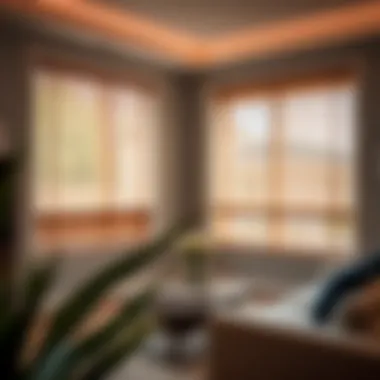
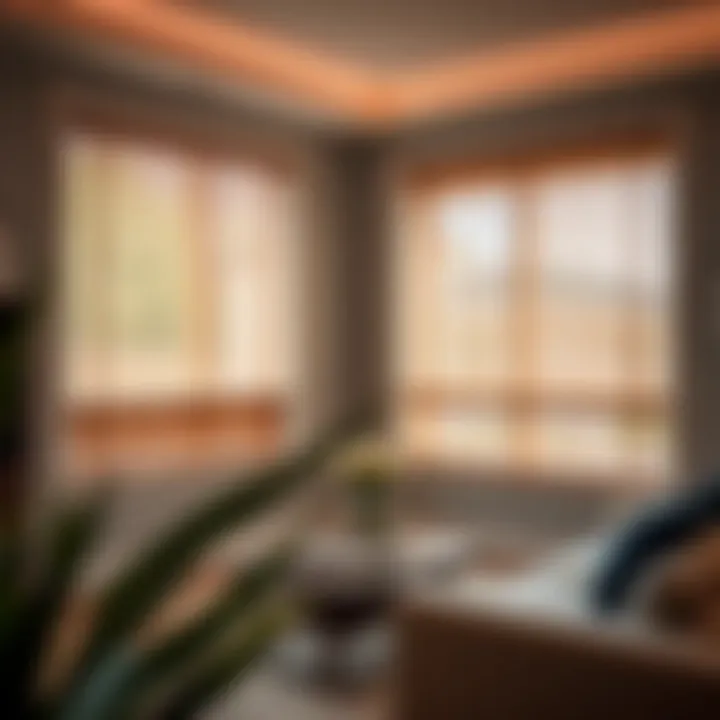
Intro
Faux wood blinds have carved out a notable niche in the world of interior design. They offer the alluring charm of traditional wood without the hefty price tag or high maintenance demands. Homeowners, decorators, and enthusiasts are increasingly turning to these versatile window treatments that blend form with function.
The appeal of faux wood blinds goes beyond mere aesthetics. They are crafted from synthetic materials, making them highly durable and resistant to moisture, which is ideal for areas like kitchens and bathrooms where real wood might warp or fade over time. A visit to any home improvement store will highlight the sheer array of choices available – from color options to design styles – providing a solution for every taste.
An examination of faux wood blinds reveals that their versatility resonates across a wide spectrum of settings, making them an optimal choice for a variety of spaces. As we delve deeper into this article, we’ll uncover insights into the latest trends and maintenance tricks that will make your home shine while maximizing your investment.
Furniture Styles and Trends
Modern vs. Traditional: Understanding the Aesthetics
When it comes to home design, the aesthetics of furniture, including window treatments like faux wood blinds, play a significant role. Faux wood blinds seamlessly fit into both modern and traditional styles, adapting to the decor narrative of your choice.
In modern settings, clean lines and minimalism prevail. Faux wood blinds can achieve this look with sleek, understated colors that maintain the room's spatial integrity. Contrastingly, traditional spaces thrive on rich textures and classic colors, giving faux wood blinds an opportunity to shine in deeper, more ornate tones that compliment rich woodwork and elegant furnishings.
Color and Material Trends: What's In and What's Out
Colors in the faux wood blind market are as diverse as the palettes of homes today. Currently trending are warmer shades that embrace a natural look, such as taupe, walnut, and chestnut.
- In:
- Out:
- Light grays and soft browns that harmonize well with popular gray finishes.
- Textured finishes that mimic real wood grain, offering an added layer of authenticity.
- Harsh whites that can feel too sterile.
- Oversaturated colors that clash with most contemporary palettes.
As for materials, while traditional blinds may have left you pondering the upkeep of real wood, faux wood offers you the peace of mind of easy cleaning, often requiring just a simple wipe down to keep them looking fresh.
"Faux wood blinds are not just an aesthetic choice; they represent a blend of functionality and style that homeowners greatly appreciate."
Furniture Care and Maintenance
Tips for Prolonging the Life of Your Furniture
Just like any other home investment, faux wood blinds require a little attention to keep them looking their best. Regularly dusting them with a soft cloth can go a long way in maintaining their appearance. In high-traffic areas, consider using a vacuum cleaner's brush attachment once in a while to remove stubborn dust build-up.
You might also think about using a mixture of mild soap and warm water for deeper cleaning. Just ensure to avoid any harsh chemicals that might damage the material.
DIY Repair Hacks for Common Furniture Issues
Despite their durability, faux wood blinds might occasionally face some wear and tear. If slats become bent, a gentle heat source such as a hairdryer, applied thoughtfully, can help restore their shape. For minor scratches, a touch-up marker in the same color as your blinds can do wonders to conceal those small flaws.
As we wrap up this discussion, faux wood blinds are a fine balance of style, utility, and affordability, adapting to both modern and classic aesthetics while also demanding minimal upkeep. Whether you are a homeowner or a designer, integrating faux wood blinds could elevate your decor and streamline maintenance to a great extent.
For more resources on home decor and maintenance, visiting sites like Britannica or Wikihow can yield fruitful tips.
Understanding Faux Wood Blinds
Faux wood blinds represent a smart blend of style and functionality. Understanding faux wood blinds isn't just about knowing what they are; it’s about appreciating the elements that make them a worthwhile choice for various environments, from cozy homes to bustling businesses. Crafted with materials such as vinyl or composite wood, these blinds offer an impressive veneer of elegance that mimics real wood. Yet, they come with a host of practical advantages that elevate them above their natural counterparts.
Definition and Composition
Faux wood blinds are designed to emulate the appearance of traditional wood blinds while using engineered materials that enhance durability. Typically made from a combination of PVC and composites, these materials are treated to withstand moisture, warping, and fading, making them ideal for areas like kitchens and bathrooms where humidity is a concern.
Unlike natural wood, faux wood's makeup is specifically engineered for resilience. For instance, they often feature a UV resistant layer to combat sun damage—a common plight faced by traditional wood options. This treatment extends their lifespan considerably, ensuring that they maintain their aesthetic appeal without the need for the care and maintenance that real wood demands. In short, their definition transcends mere appearance and touches on the practical benefits provided by innovative design.
Comparison with Real Wood Blinds
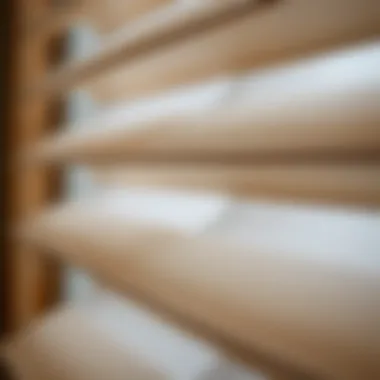
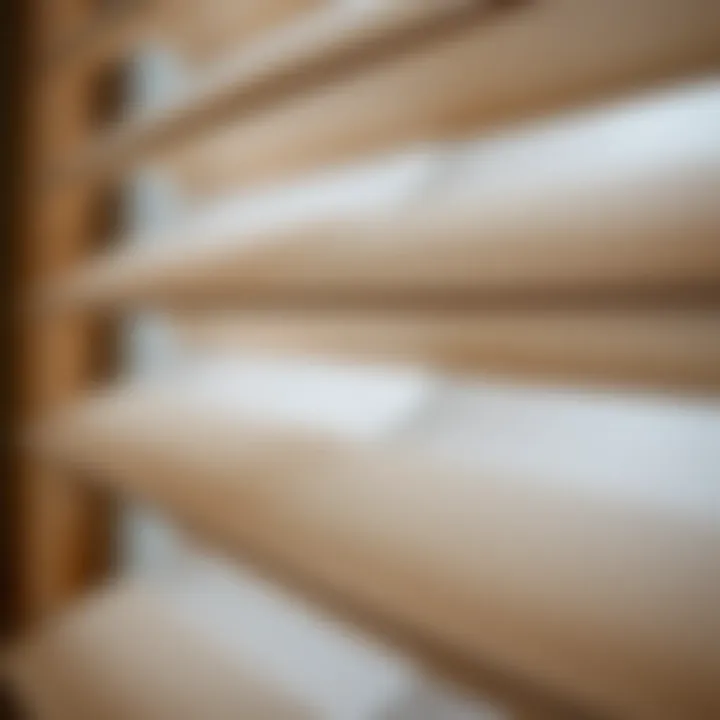
When it comes to comparing faux wood blinds with real wood blinds, the debate often starts with initial investment and extends into long-term value. Real wood blinds come with a certain undeniable charm. However, they also demand a degree of upkeep that often doesn't suit every lifestyle. Cleaning them typically involves careful dusting and vigilant avoidance of moisture. Faux wood blinds, on the other hand, are effortlessly simple to maintain. A quick wipe with a damp cloth can keep them looking pristine without fear of damage.
Beyond ease of maintenance, faux wood blinds generally cost less than their natural counterparts. This affordability, coupled with their durability, makes them an attractive option for homeowners and renters alike. If you've ever moved into a home only to cringe at the peeling layers of coating on wood blinds, you know the value that faux options can provide. They withstand the test of time and trends alike, often surpassing wood in versatility.
In fact, many designers recommend faux wood for families with children or pets, where wear and tear are simply part of life.
In summary, understanding faux wood blinds means grasping key differences with real wood blinds. It’s not just about aesthetics; it’s about how they perform in daily life, offering style without the burden of maintenance. The choice is quite clear for many—why battle with upkeep when you can enjoy effortless elegance?
Benefits of Faux Wood Blinds
Faux wood blinds have become a popular choice among homeowners and designers alike, and for good reason. These blinds offer a unique blend of style, functionality, and practicality. They cater to a diverse audience, from DIY enthusiasts to interior design aficionados, ensuring that there is something for everyone. The benefits of faux wood blinds extend beyond their appealing appearance; they encompass durability, affordability, ease of maintenance, and sustainability. Each of these aspects plays a significant role in their growing popularity. Taking a closer look at what makes faux wood blinds a sensible choice reveals why they’ve earned their spot in the limelight.
Durability and Longevity
One of the primary advantages of faux wood blinds is their durability. Unlike traditional wood, which can warp, crack, or fade over time, faux wood is designed to withstand a range of conditions. Whether it’s the harsh sunlight streaming through a window or the humidity of a steamy bathroom, faux wood blinds consistently maintain their shape and color. This resilience means less frequent replacements, saving homeowners both time and money in the long run.
In practical terms, faux wood is typically made from composite materials that are resistant to moisture and temperature changes. For instance, consider a bustling family home with kids and pets. The likelihood of spills or stains is quite high. Faux wood blinds can handle these incidents much better than their real wood counterparts. To further illustrate, a homeowner might find themselves concerned after a glass of juice is accidentally knocked over. Instead of panicking about damaging an expensive wooden blind, they can simply wipe the faux wood blind clean without a second thought.
Cost-Effectiveness
When it comes to window coverings, faux wood blinds prove to be a budget-friendly alternative. Compared to real wood blinds, faux options usually come at a fraction of the price, making them a smart choice for those looking to revamp their space without breaking the bank. In addition to the initial cost, homeowners also benefit from reduced long-term expenses due to their durability.
Imagine a scenario where one is remodeling a living room. Choosing customized faux wood blinds might cost significantly less than real wood, yet they can still deliver a polished look. This cost-effectiveness enables homeowners to stretch their budget further, allowing for investment in other areas of home decor or necessary renovations.
Maintenance and Care
Faux wood blinds shine when it comes to maintenance. Unlike wooden blinds, which often require specific cleaning products to keep them looking their best, faux wood blinds are exceptionally low-maintenance. A simple dusting and the occasional damp cloth for more stubborn stains usually do the trick. With families increasingly busy, the hassle of complex upkeep is a significant consideration. This ease of care is especially appealing to busy households.
For example, one might think of a working parent who struggles to find the time for extensive cleaning routines. With faux wood blinds, dust accumulation can quickly be dealt with by a swift swipe of a cloth, making it easy to keep the home looking neat without investing extra time.
Sustainability Considerations
In an era where sustainability matters more than ever, faux wood blinds have adopted eco-friendly practices that appeal to conscientious buyers. Many manufacturers now offer faux wood blinds crafted from recycled materials. This means less deforestation and a smaller carbon footprint. Homeowners keen on creating an environmentally conscious space can find peace of mind knowing that their choice contributes positively to the planet.
Furthermore, these blinds help maintain energy efficiency within the home. Their insulating properties can help regulate indoor temperatures, potentially reducing reliance on HVAC systems. This added layer of energy efficiency means not only lower utility bills but also a reduced environmental impact over time. The additional insulation of faux wood blinds could be likened to having a cozy blanket—keeps the space warm in winter and cool in summer.
Choosing faux wood blinds brings a multitude of benefits that collectively enhance both the functionality and aesthetics of any space. With considerations for durability, cost, maintenance, and sustainability, these blinds make a compelling case for themselves, ensuring they remain a top contender for window coverings.
Design Aesthetics of Faux Wood Blinds
In the realm of home decor, aesthetics play a pivotal role, influencing not just the visual appeal but also the ambiance of a space. Faux wood blinds bridge practical functionality and striking design, making them a popular choice for many. Understanding their aesthetic qualities can significantly impact how they complement various interiors.
Range of Colors and Styles
When browsing faux wood blinds, one quickly realizes the sheer variety available. Homeowners are not just limited to the traditional shades of brown resembling natural wood; instead, they can choose from a spectrum of colors and finishes. From crisp whites to deep charcoals, the options are broader than a kid in a candy store. This flexibility allows individuals to match or contrast with existing decor effectively.
Moreover, the styling isn't just about color. Faux wood blinds come in different slat sizes—from the narrow venetian styles to the broader plantation ones. Each variation can elicit a different atmosphere; larger slats can convey a more laid-back, rustic vibe, while narrower ones can offer a sleek, modern finish. It's this diversity in design that ensures faux wood blinds suit any personality or preference, whether one leans toward minimalism or enjoys vibrant eclectic decor.
- Customization: Many retailers allow for customization, providing options for adding decorative tapes or different ladder styles.
- Textures: Beyond just colors, textures also play a big part. Some blinds mimic the grain of real wood, while others embrace a smooth finish, allowing for layered looks depending on how light interacts with them.
These facets enable the blinds to serve as a statement piece or blend seamlessly into the background, depending upon the desired design intent.
Compatibility with Interior Design
Faux wood blinds are not merely functional; they are adaptable companions to any design narrative. Architects and interior designers find them invaluable because they can fit into both contemporary and traditional styles. Their ability to evoke warmth and familiarity means they can balance modern materials like glass and metal, softening harsher lines.
When it comes to matching these blinds with specific themes:
- Rustic or Farmhouse: The textured, wood-like finish naturally complements these aesthetics, providing an organic touch.
- Modern Minimalism: Sleek, white faux wood blinds can serve to maintain clean lines while offering light control without overwhelming a room.
- Eclectic Fusion: Various colors and styles can add an unexpected yet cohesive element to rooms filled with diverse decor.
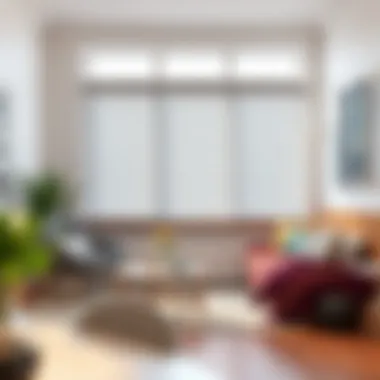
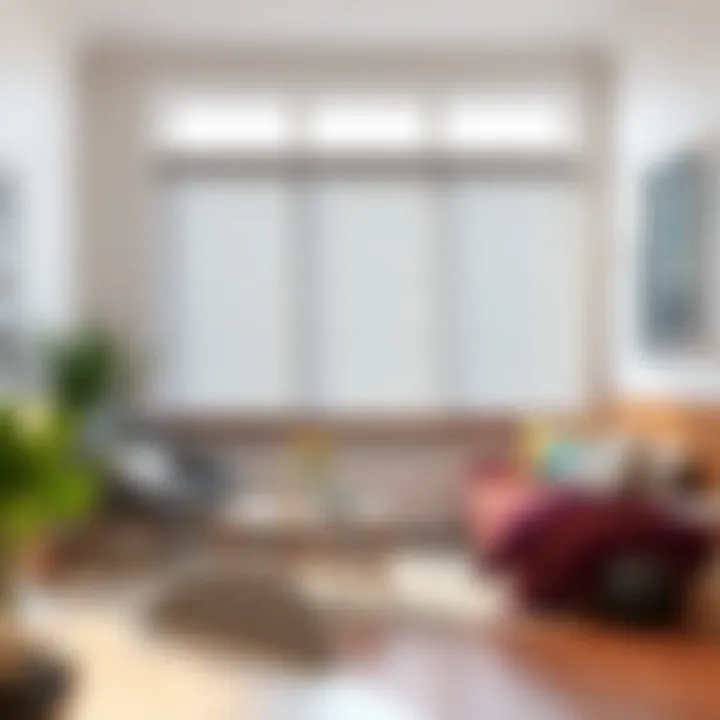
"A well-placed blind is like the cherry on top of a well-structured sundae; it can elevate an entire room's vibe."
Homeowners looking to create a cohesive look should consider how faux wood blinds can enhance room unity. Instead of competing with existing features, they augment the overall aesthetic, contributing to a polished and thoughtful interior design.
Choosing the Right Faux Wood Blinds
Choosing the right faux wood blinds is an essential decision for homeowners, designers, and anyone looking to elevate their space. The myriad of styles available can be overwhelming, yet understanding the factors that matter most can simplify this process. Faux wood blinds not only offer a striking visual appeal but also practicality that caters to various needs. In this section, we will uncover key considerations such as proper measurements and selecting the ideal size, ensuring you make an informed choice that fits your unique requirements.
Measuring Your Windows
Before one can choose faux wood blinds, getting the measurements right is a non-negotiable step. Accurate measurements guarantee that your blinds will fit snugly and operate flawlessly. Here’s how you can approach the task:
- Gather Tools: You'll need a tape measure and perhaps a notepad to jot down your findings.
- Choose the Mounting Type: Decide whether you want inside mount or outside mount. This influences the exact measurements you will take. An inside mount sits neatly within the window frame, while an outside mount overlaps the frame—potentially making your windows appear larger.
- Measure Width: For inside mounts, measure the width at three points: top, middle, and bottom. Use the narrowest measurement for your order. For outside mounts, add a few inches to the width for effective coverage.
- Measure Height: For height, again, measure at three points: left, center, and right. The longest measurement will give you the correct height. It’s crucial for that perfect look!
- Depth Counts: Especially with an inside mount, depth measurement is vital to ensure the blind fits well within the frame without issues.
Careful consideration of these details prevents costly errors down the line, making measuring your windows a straightforward yet crucial task.
Selecting the Ideal Size
Once you’ve got the measurements, the next hurdle is selecting the ideal size for your faux wood blinds. Size selection is not merely about fitting within your window; it also concerns aesthetics and functionality. Here’s how to approach it:
- Consider the Style of the Room: The right size will complement the existing decor. For example, wider slats lend a modern vibe, while smaller slats can evoke a more traditional feel.
- Think About Light Control: Width affects how much light enters your space. If your priority is controlling light more effectively, considering a size that allows for overlapping slats might be wise.
- Evaluate Privacy Needs: If privacy is paramount, then larger sizes that naturally overlap can help keep prying eyes at bay.
- Assess Window Size: Smaller windows may benefit from smaller or medium-sized blinds, while larger windows can handle wider blinds without appearing overpowering.
- Explore Custom Options: Many suppliers offer custom sizes. If stock options don’t cut it, find a retailer that can create a solution tailored to your measurements.
Choosing the right size isn’t just about grabbing the first option that fits. It’s about creating harmony within your living space, enhancing both its functionality and its aesthetic appeal.
Key Tip: Always err on the side of larger when in doubt. You can slightly adjust larger blinds, but making smaller ones work is often more challenging.
Installation Techniques
When it comes to faux wood blinds, the installation process is a key aspect often overlooked. While choosing the right blinds is crucial, how you put them up can make a significant difference in both appearance and functionality. The advantages of getting the installation right include enhanced aesthetic appeal, improved privacy, and optimized light control. Additionally, a proper install can save you time and money by avoiding the need for premature replacements or repairs.
DIY Installation Steps
Installing faux wood blinds yourself isn’t just a way to save a few bucks, but it can also give you a sense of accomplishment once you’ve done it right. Here’s a step-by-step guide to help you navigate through this task:
- Gather Your Tools: Before you begin, make sure you have a drill, screwdriver, measuring tape, level, and a pencil.
- Measure Your Windows: Accuracy here is key. Measure the width and height of your window. Be sure to measure from three points – the top, middle, and bottom for width and left, center, and right for height. This ensures that you account for any irregularities.
- Mark the Bracket Placement: With the level, mark where your brackets will go. Make sure to position them at the same height and width to ensure an even appearance.
- Drill Holes: Use the drill to make holes for the screws. Depending on your window frame material, you might need different drill bits.
- Install Brackets: Attach the brackets securely to the wall or window frame using screws. It's important these are secured tightly to hold the weight of the blinds.
- Hang the Blinds: Once the brackets are up, carefully place your faux wood blinds into the brackets. Ensure they are seated properly.
- Final Adjustments: Double-check that everything is level and functioning as it should. Make any necessary adjustments before adding any decorative elements.
By following these steps, you can turn an overwhelming task into just another weekend project.
When to Hire a Professional
While DIY can be a rewarding experience, it’s not always the right choice for everyone. Situations where hiring a professional might be beneficial include the following scenarios:
- Complex Window Shapes: If your windows are oddly shaped or oversized, the installation might require specialized knowledge.
- Lack of Tools: Not having the necessary tools can hinder your ability to perform the installation properly. In such cases, it may be better to leave it to the pros.
- Time Constraints: If you’re busy with work or other commitments, it might be more efficient to hire a professional.
- Safety Concerns: Projects that require working at heights or involve heavy lifting should probably be left to trained professionals.
On average, hiring an installer can range from $50 to $150 per window, depending on your location and the complexity of the job. If you choose to go this route, ensure that the installer has experience with faux wood blinds specifically.
In sum, knowing whether to DIY or to call in an expert not only saves you stress but can enhance the end result. Choose what suits you best, and your faux wood blinds will not only look good but function flawlessly.
Current Trends in Faux Wood Blinds
The world of faux wood blinds is witnessing a shift, mirroring changing styles and technologies in housing. As homeowners and designers seek to blend function with flair, faux wood has stepped up its game. These trends underscore the benefits of practicality alongside aesthetic appeal, addressing everything from design to tech advancements. It's critical for anyone involved in home decor to grasp these twists and turns. Let's explore the exciting developments shaking up the faux wood scene.
Innovations in Design
Design isn’t just about looks; it’s about how a product integrates into our lives. Faux wood blinds have seen a range of innovations that mean they not only look good but function smarter. For instance, there's a growing preference for textured finishes that mimic the distinct grain patterns of real wood. This new style provides a more realistic aesthetic without losing the durability faux wood offers.
Colors are also evolving. Gone are the days of basic whites and browns; today’s faux wood blinds come in a variety of shades, allowing for personalized touches. Soft muted tones are increasingly popular, fitting seamlessly into modern minimalist designs, while bold options cater to the daring decorators. The addition of unique patterns, such as chevrons or stripes, gives a fresh twist to traditional functionality.
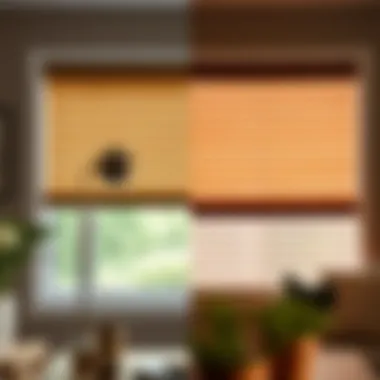
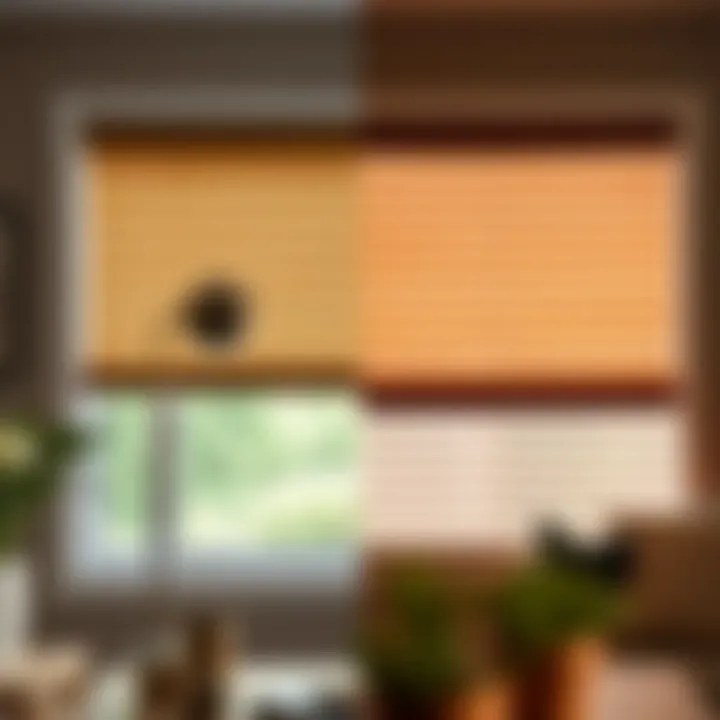
"The evolution of faux wood blinds is a testament to how design can elevate everyday products into stylish components of our spaces."
Furthermore, eco-friendly options are on the rise. Manufacturers are focusing on sustainable materials, ensuring that these blind choices align better with environmentally conscious living. This trend reflects societal shifts toward greater environmental responsibility, as buyers increasingly seek products that align with their values.
Smart Blinds Technology
Technology is not the future; it’s now. Smart blinds technology has revolutionized the way we interact with every element in our homes, faux wood blinds included. By integrating smart technology into these window treatments, homeowners gain unprecedented control. At the click of a button—or through voice commands—blinds can adjust to light levels or privacy settings with ease.
Smart faux wood blinds often incorporate features like programmable schedules, allowing you to set them to open or close at certain times of the day. Imagine waking up to natural light filtering through your blinds at dawn, only to have them close at night for optimal privacy. This kind of convenience appeals to busy lives, carving out time from chaotic schedules.
Moreover, some models now work with smart home systems such as Amazon Alexa or Google Assistant. This compatibility not only enhances user experience but also offers a chic, modern edge to home automation. The ease of use and technological advancement saves energy as well, creating a greener footprint by reducing reliance on heating and cooling systems.
Common Misconceptions
Faux wood blinds have made quite a name for themselves in the world of home decor, but despite their growing popularity, several misconceptions still linger. Addressing these misunderstandings is essential, as it helps homeowners, designers, and retail professionals make informed choices when selecting window treatments. Let's dive into two primary areas of misunderstanding that often pop up: performance myths and aesthetic misunderstandings.
Performance Myths
One of the more prevalent myths about faux wood blinds is that they don’t perform as well as real wood blinds. People believe that they lack insulation properties and won't hold up against extreme weather conditions. However, that’s just not the case. Faux wood blinds are crafted from durable materials like PVC or composite materials, which can actually exceed the energy efficiency of natural wood in some cases.
Moreover, they are designed to withstand humidity and moisture, making them ideal for spaces like kitchens and bathrooms where real wood would warp or discolor.
- Durability: Unlike their wooden counterparts, faux wood blinds are not prone to cracking, fading, or warping due to varying environmental factors. They hold up well under UV exposure, ensuring that you won’t need to replace them frequently.
- Energy Efficiency: Faux wood blinds come with excellent insulating properties which help to keep rooms cooler in the summer and warmer in the winter, thus positively impacting energy consumption.
Those who stick to the notion that faux wood blinds are inferior often miss these essential qualities. As homeowners explore the options, it’s essential to look beyond mere aesthetics and focus on practical benefits.
"A common mistake is to equate the aesthetic with performance. Faux wood blinds can deliver both if picked rightly."
Aesthetic Misunderstandings
Now, moving onto the realm of aesthetics, many believe that faux wood blinds lack the visual appeal of real wood. This is a misconception driven by outdated perceptions. In today’s market, faux wood blinds come in a vast array of colors, finishes, and styles mimicking the look of natural wood closely. What’s even better? They offer design flexibility that real wood cannot.
- Versatile Options: Faux wood blinds come in a multitude of shades and textures, allowing you to select designs that fit any interior decor style, from rustic to modern.
- Finish Flexibility: Whether a sleek white for a contemporary room or a rich cherry to accentuate classic furniture, faux wood blinds present options that can match or even enhance the visual narrative of a space.
Homeowners should embrace the possibilities that faux wood blinds provide, beyond merely thinking of wood as the gold standard in aesthetic appeal. They can achieve a sophisticated look while benefitting from durability and ease of maintenance. In the end, the key lies in realizing that faux wood blinds can serve as a powerful tool in an interior designer's arsenal.
Faux Wood Blinds in Different Settings
Faux wood blinds present a versatile option that caters to various environments, whether in cozy homes or bustling commercial spaces. Their adaptability not only enhances aesthetics but also serves practical purposes, making them a standout choice in regions with differing climates and specific functional needs. When discussing faux wood blinds, it’s crucial to recognize how these products can be tailored to suit distinct settings, accommodating both personal style and functional requirements. By exploring both residential and commercial applications, we gain a clearer understanding of just how impactful faux wood blinds can be in our daily lives.
Residential Applications
In residential spaces, faux wood blinds shine for a multitude of reasons. They are not just about utility; they bring warmth and style into a home, positioning themselves as a central aspect of interior design.
- Increased Privacy: Homeowners often seek to create private havens from the outside world. Faux wood blinds effectively block unwanted views while allowing homeowners to control light levels, ensuring comfort throughout the day.
- Variety in Style: Faux wood blinds come in a multitude of colors and finishes, making them easy to match with existing decor. For instance, a light oak finish can complement a rustic farmhouse style, whereas a deep espresso shade could align with modern minimalist aesthetics.
- Enhanced Durability: Given that residential spaces can experience drastic temperature changes, faux wood blinds are less susceptible to warping and fading than their real wood counterparts. This longevity makes them a smart investment, especially in areas with high humidity such as kitchens and bathrooms.
- Ease of Cleaning: A quick wipe is usually all that’s required to maintain these blinds, making them ideal for busy households. Pets and children can often lead to messes, but faux wood material is forgiving, resisting stains and scuffs.
Commercial Use
Commercial applications for faux wood blinds are equally compelling. For businesses, the choice of window treatments can reflect both the identity of the company and its commitment to functionality.
- Professional Appearance: In an office setting, faux wood blinds provide a polished look that contributes to a professional ambiance. Imagine a consulting firm with sleek, dark faux wood blinds framing floor-to-ceiling windows—they enhance the setting’s seriousness while still providing warmth.
- Control Over Light and Glare: In environments such as stores or offices, glare from the sun can disrupt work and deter customers. Faux wood blinds can be adjusted easily to mitigate this issue, thus ensuring staff comfort and maintaining an inviting atmosphere for customers.
- Cost-Efficiency: Businesses often face budget constraints, and faux wood blinds present a cost-effective alternative to real wood. They fulfill both aesthetic and functional roles without straining the budget, which is crucial for maintaining profitability.
- Accessibility: Faux wood blinds can be adjusted with ease, allowing for quick modifications as necessary. In open concept spaces, this flexibility helps adapt to fluctuating natural light, promoting greater comfort throughout different times of the day.
"Choosing the right window treatments, like faux wood blinds, can significantly enhance the functionality and aesthetic of both residential and commercial spaces."
The End
In wrapping up our discussion on faux wood blinds, it's important to accentuate just how versatile they truly are. For homeowners, designers, retailers, and DIY enthusiasts, these blinds offer more than just a means to block out light. They present a blend of functionality, style, and value that resonates through every corner of the home environment. The insights covered throughout our exploration demonstrate that faux wood blinds hold several advantages over their traditional wooden counterparts, particularly in terms of durability and affordability.
Summarizing Key Insights
Faux wood blinds have carved out a niche in both residential and commercial spaces. Here are the highlights:
- Durability: Unlike their real wood cousins, faux wood blinds are less susceptible to warping, cracking, or fading. This makes them a preferable choice in high-humidity areas.
- Cost-Effectiveness: They are easier on the wallet, offering a similar aesthetic to wood at a fraction of the price. This appeal is crucial for budget-conscious shoppers.
- Maintenance: Simple cleaning and care routines ensure these blinds remain in great condition with little effort. A damp cloth is usually all that’s needed for maintenance, making them ideal for busy households.
- Design Versatility: From classic to contemporary, faux wood blinds are available in a plethora of styles and colors, lending themselves easily to various interior design themes. Homeowners can find the right match for any décor plan without breaking a sweat.
- Sustainability: Often made from recycled materials, faux wood blinds are also a more environmentally friendly option, aligning with sustainable living practices.
"Faux wood blinds reflect both the needs of practical application and the desire for aesthetic appeal in modern design."















